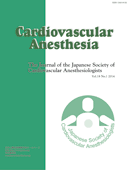Volume 18, Issue 1
Displaying 1-13 of 13 articles from this issue
- |<
- <
- 1
- >
- >|
-
2014Volume 18Issue 1 Pages pre-1
Published: 2014
Released on J-STAGE: October 21, 2014
Download PDF (164K)
-
2014Volume 18Issue 1 Pages 1-8
Published: 2014
Released on J-STAGE: October 21, 2014
Download PDF (390K)
-
2014Volume 18Issue 1 Pages 9-13
Published: 2014
Released on J-STAGE: October 21, 2014
Download PDF (304K)
-
2014Volume 18Issue 1 Pages 15
Published: 2014
Released on J-STAGE: October 21, 2014
Download PDF (182K)
-
2014Volume 18Issue 1 Pages 17-20
Published: 2014
Released on J-STAGE: October 21, 2014
Download PDF (241K) -
2014Volume 18Issue 1 Pages 21-24
Published: 2014
Released on J-STAGE: October 21, 2014
Download PDF (187K) -
2014Volume 18Issue 1 Pages 25-28
Published: 2014
Released on J-STAGE: October 21, 2014
Download PDF (2160K) -
2014Volume 18Issue 1 Pages 29-33
Published: 2014
Released on J-STAGE: October 21, 2014
Download PDF (5793K) -
2014Volume 18Issue 1 Pages 35-40
Published: 2014
Released on J-STAGE: October 21, 2014
Download PDF (670K) -
2014Volume 18Issue 1 Pages 41-44
Published: 2014
Released on J-STAGE: October 21, 2014
Download PDF (195K) -
2014Volume 18Issue 1 Pages 45-49
Published: 2014
Released on J-STAGE: October 21, 2014
Download PDF (1347K) -
2014Volume 18Issue 1 Pages 51-54
Published: 2014
Released on J-STAGE: October 21, 2014
Download PDF (438K)
-
2014Volume 18Issue 1 Pages 55-60
Published: 2014
Released on J-STAGE: October 21, 2014
Download PDF (303K)
- |<
- <
- 1
- >
- >|
